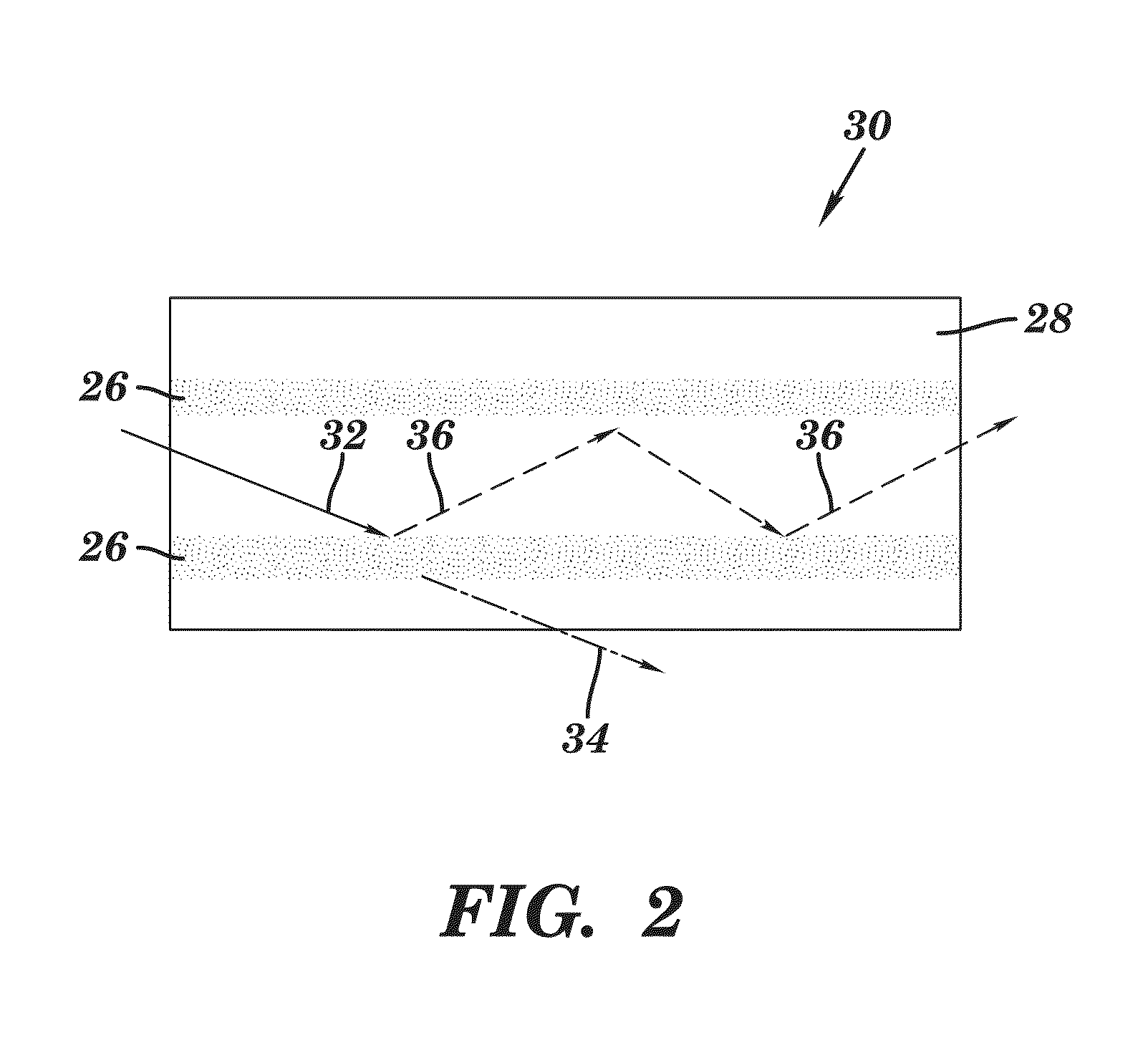As known in the art, the problem associated with
thermocouple-based sensing probes is that the sensor performance degrades significantly with time.
Accordingly, the stringent requirements for high
temperature sensing under harsh conditions have made the conventional thermoelectric
thermal radiation sensing methods inadequate for harsh conditions.
Though silica based fibers can provide effecting sensors, silica-based fibers are not applicable for sensing at ambient temperatures greater than 800 degrees C., because, as noted by Fernando, et al.
Since chemical reactions between
fiber materials and their surroundings can substantially change
fiber material properties, resulting in severe degradation in sensor performance, and even the complete failure of sensors due to
chemical corrosion.
Though, as shown in Table 1,
sapphire fibers have marked differences in characteristics that suggest
sapphire is preferable to silica for harsh environments, the major issue limiting the use of sapphire-based fiber sensors in an
industrial setting is the lack of reliable claddings for sapphire fibers, particularly at temperatures above 1000 degrees C.
In addition, small size sapphire fibers (that is, having an outside
diameter less than 10 micrometers [μm]) are currently unavailable in the field, and thus single-mode
optical propagation within sapphire fibers is essentially impossible, which is another drawback for sapphire-based fiber-
optics sensing.
Although the
refractive index of air is less than that of fiber materials, air cannot serve as an effective cladding for sapphire fibers.
These characteristics of sapphire fibers can cause difficulties for the fabrication and operation of
sapphire fiber sensors.
Moreover, a further
disadvantage of sapphire-fiber-based sensing is that the intensity of optical signals in sapphire fibers can be significantly decreased as a result of strong
light scattering at the fiber-
air interface, if the fibers are not properly clad.
This is particularly severe for
sensing applications in harsh environments where constantly varied surrounding atmospheres, deposited dust, and defects (for example, scratches and / or cracks) can develop on the fiber surface, among other places, that can result in unsatisfactory optical
signal losses.
Accordingly, the use of sapphire-based optical sensors can be impractical, or even substantially impossible, for delivering and detecting optical signals when a large fiber length (that is, greater than 0.5 m) is needed, as in the case of multi-point sensing for oversized facilities, such as, power plants and gasifiers.
However, the presence of cladding can also affect the number of propagating
modes allowable within fibers.
Unlike silica-based fibers, core-clad structures for
single crystal sapphire fibers are unattainable during their growth.
However, none of these efforts has yielded satisfactory performance for
sapphire fiber cladding in harsh environments, particularly at temperatures around and above 1000 degrees C.
For ambient temperatures above 1000 degrees C., even a small difference in such thermal characteristics between sapphire and the cladding material can result in mechanical failures (for example,
cracking and / or
delamination of the cladding from the fiber surface) of claddings due to stress buildup.
It is well known in the art that, with the present state of the art, it is very difficult (if not impossible) to obtain a cladding material that satisfies all these stringent requirements that can be used effectively for
sapphire fiber cladding, for example, for harsh environment
sensing applications.
Consequently, the inventors have found that there has been no viable technology available in the art that would allows sapphire fibers to be properly clad for use under harsh-environment conditions, for example, involving high temperatures (for example, greater than 1000 degrees C.) and resistance to high
chemical corrosion and / or
erosion.
As known in the art, the electronic
polarizability (α) depends on the chemical bonding of the material, and a dramatic reduction in the electronic
polarizability is typically difficult to achieve without significant change of constituting
chemical species in the material matrix.
During this impingement, various
ion-
solid interactions take place as the energetic ions
traverse the material, and typically lead to modifications in material properties.
These nuclear collisions displace the constituent atoms from their original locations, leaving a
high density of defects (for example, voids, vacancies, and / or interstitials) in the material.
However, the present inventors have found that this prior art has been limited to
room temperature or relatively low
processing temperatures conditions for the fabrication and operation of
ion implantation produced waveguides, specifically to
processing temperatures less than 200 degrees C. Accordingly, the prior art teachings, waveguides, and barriers are not applicable to conditions for higher temperatures, for example, temperatures greater than 200 degrees C., that is, those temperatures that characterize the harsh environments typically encountered in certain industrial processes, as discussed above.
 Login to View More
Login to View More 


